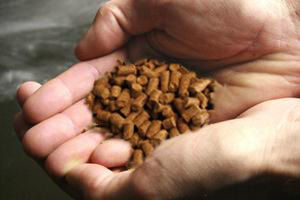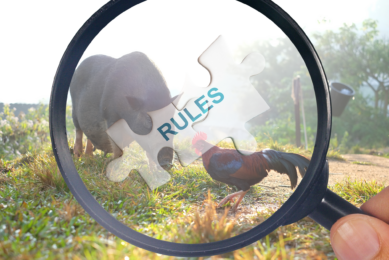New regulation brings PAPs back into fish feed

The Joint Research Commission (JRC) have recently released reference material facilitating the implementation of the new Commission regulation that re-authorised the use of processed animal proteins (PAPs) in fish feed earlier this year.
The new reference material IRMM-AD482 will facilitate the implementation by control laboratories of a test that detects the absence or presence of ruminant PAPs in feed material obtained from non-ruminants. This will allow feeding farmed fish and other aquaculture animals with non-ruminant PAPs again. The re-authorisation will improve the overall sustainability of the aquaculture sector, since these PAPs could be a valuable substitute for fishmeal, which is a scarce resource.
Animal by-products are derived from parts of slaughtered animals that are in principle fit for human consumption but are not used for production of food (e.g. udder, ovary, bones). If properly sterilised, these products, called processed animal proteins (PAP), are a valuable protein source in animal nutrition. However, if materials not fit for human consumption such as diseased animals are processed, especially without the appropriate sterilisation treatment; animal by-products may endanger the animal feed with these materials as well as the health of consumers. Improperly heated animal by-products fed to cattle were identified as the root-cause for mad cow disease. Therefore, in 2001 all animal by-products were banned as feed ingredients to eradicate the mad cow (bovine spongiform encephalopathy, BSE) disease.
The European Commission’s Strategy paper on Transmissible Spongiform Encephalopathies for 2010-2015 (TSE Road map 2) emphasised that a partial lifting of the PAP ban to allow their re-introduction for certain animals should be primarily driven by scientific evidence. In 2009, the JRC‘s Institute for Reference Materials and Measurements contributed to the TSE Road map by developing a specific marker for PAPs obtained from diseased animals or from specified risk materials (such as bovine brain and spinal cord) that must not enter the feed-food chain (instead, such material has to be disposed of). Having this tool, it was then possible to re-authorise PAPs derived from healthy non-ruminant farmed animals (i.e. mainly pigs and poultry) to be used in fish feed as of June 2013.
In collaboration with the EU Reference Laboratory for animal proteins in feeding stuffs (EURL-AP), which is hosted by the Walloon Agricultural Research Centre (CRA-W), the JRC contributed to the validation of new diagnostic spectroscopic and DNA-based methods for identifying PAPs coming from different animal species. The new Regulation includes these validated methods, which are based on the polymerase chain reaction (PCR) for the detection of animal constituents in feed. The PCR methods have been designed to target DNA fragments of ruminant origin (e.g. beef-cattle, sheep, and goats), which can be detected even in heavily processed feed samples.
The re-introduction of safe and nutritionally valuable PAPs derived from non-ruminant farmed animals in feed for fish shows the importance of evidence-based scientific advice. Twelve years ago the lack of measurement methods contributed to the total ban of PAPs. However, JRC scientists have significantly contributed to the development and provision of new quality assurance tools, namely validated methods and a reference material. These allow lifting the ban to the benefit of the aquaculture sector, while at the same time protecting the well-being of consumers and ensuring the safety of the food chain.











